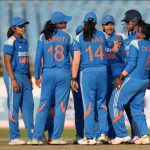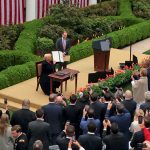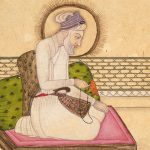Sword of the Brother Enemy
What is the way forward?
 Shashi Tharoor
Shashi Tharoor
 Shashi Tharoor
Shashi Tharoor
 |
22 Sep, 2016
|
22 Sep, 2016
/wp-content/uploads/2016/09/Enemyborther1.jpg)
THE URI ATTACK in the early hours of Sunday that has claimed the lives of 18 Indian jawans confirms yet again that nearly seven decades after Independence and Partition, Pakistan remains India’s biggest foreign policy challenge.
Pakistan was hacked off the stooped shoulders of India by the departing British in 1947 as a homeland for India’s Muslims, but (at least until very recently, if one can extrapolate from the two countries’ population growth trends) more Muslims have remained in India than live in Pakistan. Pakistan’s relations with India have ever since been bedevilled by a festering dispute over the divided territory of Kashmir, India’s only Muslim-majority state. Decades of open conflict and simmering hostility, punctuated by spasms of bonhomie that always seem to sputter out into recrimination, and now marked by repeated incidents of cross-border terror from Pakistan of which Uri is merely the latest example, have characterised a relationship that has circumscribed India’s options and affected its strategic choices.
In his recent book India vs Pakistan: Why Can’t We Just Be Friends? (Juggernaut, Rs 299), Husain Haqqani blames both sides for this, but especially ‘Pakistan’s near pathological obsession with India’ and the ‘paranoia’ of its elite, fuelled by the resentment of emigrés from India who developed ‘a national narrative of grievance’. These migrants, who did not hail from the territory of the country they were ruling, had to develop and sustain an ideological narrative about Pakistan, giving birth to a nationalism that was reductive: Pakistan’s principal raison d’être became that it was not India and that it defined its interests in opposition to India’s.
The ‘two-nation theory’ that Hindus and Muslims could not live together, and the notion of a thousand years of conflict between the two peoples, had to be created, justified and propagated, including through the ‘prescribed myths’ of tendentious history textbooks. As the Pakistani commentator Khaled Ahmed observed: ‘Pakistani nationalism comprises 95 per cent India hatred. They call it Islam because that is how we learn to differentiate between ourselves and India.’ Islam became central to Pakistan’s sense of itself: as the academic Waheed uz-Zaman put it in 1973, “If the Arabs, the Turks, the Iranians, God forbid, give up Islam, the Arabs yet remain Arabs, the Turks remain Turks, the Iranians remain Iranians, but what do we remain if we give up Islam?” One Pakistani official answered the question to The New York Times in 1980: “second-rate Indians”.
Haqqani explains all this very well, as well as the other factors that sustain Pakistani hostility to India. At Partition, Pakistan received, thanks to the lopsided application of the ‘martial races’ theory by the British, a larger share of undivided India’s military than of either its population or territory. With 21 per cent of India’s population and 17 per cent of its revenue, Pakistan got 30 per cent of the Indian Army, 40 per cent of the Indian Navy and 20 per cent of the Indian Air Force, obliging its government to devote 75 per cent of the country’s first budget to cover the costs of maintaining this outsize force. The disproportionately large military establishment had a vested interest in its own perpetuation; as Haqqani points out, it ‘needed a threat if it was to be maintained’. Sadly, instead of cutting back on its commitments to the military, Pakistan kept feeding the monster till it devoured the country itself. Even when Pakistan lost half its territory in the disastrous Bangladesh War of 1971, the army continued to expand.
THE CENTRAL PROBLEM bedevilling the relationship between the two subcontinental neighbours is not, as Pakistani propagandists like to suggest, Kashmir, but rather the nature of the Pakistani state itself—specifically, the stranglehold over Pakistan of the world’s most lavishly funded military (in terms of percentage of national resources and GDP consumed by any army on the planet). To paraphrase Voltaire on Prussia, in India, the state has an army; in Pakistan, the army has a state. Unlike in India, one does not join the army in Pakistan to defend the country; one joins the army to run the country. The military has ruled Pakistan directly for a majority of the years of its existence, and indirectly for most of the rest. Until 2008-13, no previous elected civilian government had been allowed to complete its full term; Zulfikar Ali Bhutto was an exception but he was arrested (and later hanged) immediately after he completed his initial tenure. The army lays down the ‘red lines’ no civilian leader—and not even the ‘free’ media—dare cross. In return, the military establishment enjoys privileges unthinkable in India. In addition, serving and retired military officials run army-controlled shopping malls, petrol stations, real-estate ventures, import-export enterprises, and even universities and think tanks. Since the only way to justify this disproportionate dominance of Pakistani state and society is to preserve the myth of an ‘Indian threat’, the Pakistani military will,many in India believe, continue to want to keep the pot boiling, even if Kashmir were to be handed over to them on a silver salver with a white ribbon tied around it. In the analysis of the Pakistani commentator Cyril Almeida, the army is not strategically interested in peace; it may not want war (which general relishes dying?) but it does not want peace either.
For half the country’s existence, the military has ruled Pakistan directly after a series of coups; the rest of the time it has stayed in the shadows, controlling the elected civilian governments and calling the shots on foreign and security policy (especially vis-à-vis India) that no government dares challenge. Even civilian leaders with a popular base, like Zulfiqar Ali Bhutto, bribed the military with generous allocations in the vain hope that this would forestall a coup against them. No Pakistani leader has had the courage, or the foolhardiness, to confront the military’s stranglehold on power.
American backing for Pakistan as a Cold War ally also absolved the country of the obligation to deal constructively with India. Its strategic choice of drawing closer to the Arab West Asia accentuated a sense of Islamism within Pakistan and brought petrodollars and fundamentalist interpretations of Islam into the mix. Pakistani clerics and worse, official (and officially directed) mass media, evolved and assiduously reiterated the theory of the Ghazwa-e-Hadith, under which the Prophet himself had predicted a ‘final battle’ in Hind before the End of Times. Jihadi groups were spawned, nurtured and indoctrinated with the belief that every one of their assaults on Indians were ‘part of the Battle for India promised by Islam’s Prophet’. But as Dr Frankenstein discovered when his monster escaped his control, such doctrines can bite their own creators; some jihadi groups, notably the Pakistani Tehreek-e-Taliban, realised that ‘Hind’ in the Prophet’s time included what is today Pakistan, and used the same Ghazwa-e-Hadith to justify terrorist attacks on ‘godless’ installations of Pakistan’s military establishment in the name of Islam.
In India, the state has an army; in Pakistan, the army has a state. Unlike in India, one does not join the army in Pakistan to defend the country; one joins the army to run the country
WHERE DO WE go from here? Jawaharlal Nehru, as Haqqani reminds us, had predicted of the two countries that ‘we can either become more than friends or more than enemies’. The latter seems to have happened. Even the unspeakable tragedy of the terrorist slaughter of schoolchildren in Peshawar did not lead Pakistan to cauterise the festering sores of terrorism their own ISI has incubated.Until those who rule Pakistan see that India is not their real enemy but the extremism they fanned is, there is little hope that peace can emerge from the carnage all around us.
One of the problems in the India-Pakistan relationship is that it is the last one left with sharply opposed binaries. The two sets of ideas in India for dealing with Pakistan involve a choice between those advocating a military attack on the sources of terrorism, and ‘peace at any price’. Our leaders are either exchanging sentimental letters about their mothers or ignoring each other in a stagnant silence. Too much of Indian public opinion is divided into sharply polarised camps of hawks and doves—the former insisting on nothing less than implacable hostility towards Islamabad, the latter advocating talks with whoever is in office in Islamabad, through a process ‘uninterruptable’ even if new terrorist strikes emanating from Pakistan were to occur.
Neither position, in my view, is tenable. Hostility is a mood, not a policy, and hostility in perpetuity is neither viable nor desirable between neighbours. And while the doves may be right that New Delhi’s visceral reaction to the terror attacks is tantamount to giving the terrorists a veto over our foreign policy choices, no democratic government can allow its citizens to be killed and maimed by forces from across the border without reacting in some tangible way that conveys to Pakistan that there is a price to be paid for allowing such things to happen. At the same time, bombing the terrorist training camps at places like the Lashkar-e-Toiba’s 2,000-acre campus at Muridke, as the hotheads advocate, can only prove counterproductive, cementing the popular hostility we are seeking to eliminate.
What, then, is the way forward for India? It is clear that we want peace more than Pakistan does, because we have more at stake when peace is violated. To those who suggest that we should simply ignore our dysfunctional neighbours, accept the occasional terrorist blast (and prevent the ones we can), tell ourselves there is nothing we need from Pakistan and try to get on with our development free of the incubus of that benighted land, there is only one answer: we cannot grow and prosper without peace, and that is the one thing Pakistan can give us that we cannot do without. We cannot choose to be uninterested in Pakistan, because Pakistan is dangerously interested in us.
By denying us the peace we crave, Pakistan can undermine our vital national interests, above all that of our own development. Investors shun war zones; traders are wary of markets that might explode at any time; tourists do not travel to hotels that might be commandeered by crazed terrorists. These are all serious hazards for a country seeking to grow and flourish in a globalising world economy.
Even if Pakistan cannot do us much good, it can do us immense harm, and we must recognise this in formulating our policy approaches to it. Foreign policy cannot be built on a sense of betrayal any more than it can be on illusions of love. Pragmatism dictates that we work for peace with Pakistan precisely so that we can serve our own people’s needs better.
But we must do this without illusions, without deceiving ourselves about the existence of genuine partners for peace across the border, and without being taken in by the insincere press releases of the civilian rulers who are occasionally allowed to don the masks of power in Pakistan.
We must accept that the very nature of the Pakistani state condemns us to facing an implacable enemy in the self-perpetuating military elite next door, for lasting peace would leave them without a raison d’etre for their power and their privileges.
We must not be deluded into making concessions, whether on Kashmir or any other issue, in the naive expectation that these would end the hostility of the ISI and its extremist cohorts. As Haqqani says, Kashmir is not a cause of the conflict between the two states, but rather a symptom of it. Pakistan’s claim to Kashmir is based on it being a Muslim-majority state at the time of Partition; as Haqqani points out, Sardar Patel was inclined to accept this logic until Pakistan cynically accepted the accession of Hindu-majority Junagadh when its Muslim Nawab sought to attach himself to the fledgling new country. The pursuit of Kashmir is a means to a larger end, the defeat and disintegration of India.
Jawaharlal Nehru had predicted of the two countries that ‘we can either become more than friends or more than enemies’. The latter seems to have happened
We must understand that Pakistan’s fragile sense of self- worth rests on its claim to be superior to India, stronger and more valiant than India, richer and more capable than India. This is why the killers of 26/11 struck the places they did, because their objective was not only to kill and destroy, but also to pull down India’s growth, tarnish its success story and darken its lustre in the world. The more we grow and flourish in the world, the more difficult we make it for the Pakistani military to sustain its myth of superiority or even parity. (The mutual nuclear tests of 1998 have indeed created a nuclear parity between the two nations that did not exist when their nuclear capacity was unknown and India enjoyed an overwhelming conventional military advantage.) There are malignant forces in Islamabad who see their future resting upon India’s failure. These are not motives we can easily overcome.
Haqqani argues that ‘the strong belief in the righteousness of Pakistan’s claim to Kashmir has never been accompanied by a coherent strategy or a well-considered endgame to get it.’ Pakistan has rejected every available compromise solution that has been offered in the forlorn hope that ‘the situation in Jammu and Kashmir would worsen to a point where India’s grip on the state becomes untenable’. The nationalist frenzy stoked by militant and terrorist organisations within Pakistan (like Harkat- ul-Ansar, Lashkar-e-Toiba and Jaish-e-Mohammed, all created and surviving with official patronage, most notably from the ISI) has narrowed the options available to Pakistani leaders, since opposition to these groups’ methods results in instant accusations of treason. But instead of weakening India through the ‘death of a thousand cuts’, Pakistan’s sponsorship, training and despatch of militant jihadists into Indian territory has only hardened India’s resolve. Meanwhile, Pakistan remains locked into intransigence, unable to shift its priorities away from the military’s preferred agenda. ‘Is Kashmir really Pakistan’s ‘jugular vein’,’ Haqqani asks, using Jinnah’s famous expression, ‘if the country has survived for sixty-nine years without it?’
At the same time Pakistan has to nurture the fatuous notion of an Indian threat, even though it possesses nothing that India wants. As far back as 1963, US Secretary of State Dean Rusk had commented sardonically that “Pakistan pretends to be convinced that India has never accepted Partition and seeks the disappearance of Pakistan.” Islamabad continues to cite alleged Indian involvement in Baluchistan and Sind as proof of New Delhi’s desire to break up Pakistan. The defeat in Bangladesh obviously rankles, and many in the Pakistani military are determined to do to India in Kashmir what India did to Pakistan in East Bengal. ‘As long as the belief exists that Pakistan must undermine India before India does the same to Pakistan,’ says Haqqani, ‘it is unlikely that terrorism will stop being an issue in the Subcontinent.’
The killers of 26/11 struck the places they did because their objective was not only to kill, but also to pull down India’s growth, tarnish its success story
The doctrine of ‘irregular warfare’ as a preferred military strategy for Pakistan goes back a long way to Ayub Khan’s regime, as Haqqani shows. It entails the use of the irregular insurgent as an adjunct of the regular soldier in a ‘hit-terrorise- run or die appraoch’, reducing the need for the direct involvement of the army in operations that require deniability. ‘Being smaller than India,’ he writes, ‘Pakistan cannot succeed in a conventional military offensive but it hopes to force India’s hand by disrupting life in its cities and creating fear all around.’ Haqqani is direct and honest in writing that ‘Pakistan adopted terrorism as a low-cost means of bleeding India, assuming that it could replicate what many nations had done together against the Soviets in Afghanistan.’ The hope is ‘to inflict sufficient pain on India to force surrender’.
India has shown Pakistan that our threshold of pain is high enough for that strategy not to work, but that is not enough. In my own view, it is time for a different approach: one that separates the issue of political dialogue from that of trade and people-to-people contact. Yes, punish each incident of violence by freezing official talks: let the Pakistanis understand that if they want to talk to us officially, they have to take credible steps to rein in Lashkar-e-Toiba and Hafiz Saeed, and they have to punish the 26/11 killers whose trial has so far been a travesty.
At the same time, we should open our doors and hearts to Pakistanis who have nothing to do with the military establishment. Haqqani observes that India ‘could reach out to the Paksitani people and convince them that it does not seek Pakistan’s break up’ but that the ‘sustained engagement and outreach’ this requires is made difficult by our domestic politics. I wish he had developed this argument and outlined what exactly India could do to change the parameters of this dysfunctional relationship. In my view, India can build on the generosity it has often shown—as witness the unilateral most-favoured nation status it gave Pakistan in 1996—by extending itself to its neighbour, offering a market for Pakistani traders and industrialists, a creative umbrella to its artists and singers, an enthusiastic market for its fashion designers, and a home away from home for those seeking a refuge from the realities of Pakistani life. The majority of Pakistanis are not jihadis. Multiplying our channels of contact away from Track-I and Track-II to embrace the ordinary people of Pakistan would put both countries back on the right track—towards genuine peace.
Sadly, India has reacted to 26/11 and other Pakistani provocations by punishing the wrong people—tightening visa restrictions and restraining other possibilities of cultural and social contact. The terrorists of 26/11 did not apply for Indian visas before coming onshore with their deadly baggage. Those who apply are genuinely people of goodwill towards, and interest in, India.
The advantages of openly issuing visas and enhancing opportunities for Pakistanis in India outweigh the dangers; after all, almost every Pakistani visitor here is entranced by the land that Partition has denied to them. I am strongly in favour of a liberal visa regime, which would require India to remove its current restrictions on which points of entry and exit the Pakistani visa-holder can use, the number of places that may be visited, and the onerous police reporting requirements. To begin with, a list can be drawn up of prominent Pakistanis in such fields as business, entertainment and media, who would be eligible for more rapid processing and for five-year multiple-entry visas.
Let us show a magnanimity and generosity of spirit that in itself stands an outside chance of persuading Pakistanis to rethink their attitude to us
It will be argued that Pakistan will not reciprocate such one- sided generosity, but India should not care. Insisting on parity with Pakistan is to bring ourselves down to their level. Let us show a magnanimity and generosity of spirit that in itself stands an outside chance of persuading Pakistanis to rethink their attitude to us.
This attitude in fact represents a change from that which prevailed at the time of Partition. As Haqqani shows at the very beginning of his book, Jinnah intended India and Pakistan to have ‘an association similar to that between the United States and Canada’. He even suggested to an American interlocutor a joint defence agreement with India. Haqqani says that passports and visas only became required for travel between the two countries as late as 1965. Initially, despite Partition, national identities remained fluid: Pakistan’s first nominee as High Commissioner to India, Mohammad Ismail, wished to remain an Indian citizen (to protect his properties in UP) while being accredited to his own country as an envoy!
Even if we cannot go back to those old ways of thinking, let us show the same sort of spirit from our side. Tell Pakistani businessmen that if they can get their government to reciprocate India’s two-decade-old practice of Most Favoured Nation status in trade relations, it will result in India taking concrete steps to reduce the non-tariff barriers relating to security inspections and clearances that have limited the extent of Pakistani exports to our country. India’s financial services industry and its software professionals could also offer themselves to Pakistani clients, giving themselves a next-door market and providing services that Pakistan could use to develop its own economy. These are all ‘easy wins’ waiting to be pursued at the first opportunity.
THE BIG QUESTIONS—the Kashmir dispute and Pakistan’s use of terror as an instrument of policy—will require a great deal more groundwork and constructive, step-by-step action for progress to be made. But by showing accommodativeness, sensitivity and pragmatic generosity in all the ways suggested above, India might be able to turn the bilateral narrative away from the logic of intractable hostility in which both countries have been mired for too long. That might even make substantive official talks possible again one day. It would make a change from the stagnation that is currently our only policy.
Kashmir is not a cause of the conflict, but rather a symptom of it. The pursuit of Kashmir is a means to a larger end, the defeat and disintegration of India
Accepting Pakistan the way it is but pushing for peace nonetheless is, in my view, the only way forward. It will mean isolating those elements and those issues that both sides consider intractable, and placing them on the back burner for now, in order to proceed with those that can be solved. Trust and understanding can be built on the basis of insaaniyat—welcoming non-official Pakistanis—thereby improving the atmosphere within which the more difficult problems can be tackled.
Haqqani makes the point to his own military establishment that ‘Seeking security against a much larger neighbour is a rational objective but seeking parity with it constantly is not.’ Pakistanis are ‘not told’, he writes, about ‘the widening gap between the two countries in most fields’. He argues that Pakistan should ‘concentrate on building its democracy, eliminating terrorism, improving its infrastructure and modernising its economy.’ None of us in India can persuade Pakistan to adopt those priorities. But by adopting the policies I have suggested, we can certainly improve the environment within which a Pakistani government might consider making such a choice.
A former Indian High Commissioner to Pakistan, G Parthasarathy, once famously remarked that promoting peace between India and Pakistan is like trying to treat two patients whose only disease is an allergy to each other. This allergy has to be overcome. India does not covet any Pakistani territory. Because we wish to focus on our own people’s development and prosperity in conditions of security, we remain committed to long-term peace with Pakistan. Reaching out to Pakistanis is the right thing to do. We’ve tried everything else.
About The Author
CURRENT ISSUE
Rashmika Mandanna: India’s Sweetheart
MOst Popular
3

/wp-content/uploads/2025/04/Cover-Rashmika-New.jpg)













More Columns
CPM alarmed by shrinking student base Ullekh NP
With No Big Win, BCCI Says No To Hike In Annual Retainership For Women Short Post
The Legacy of Manoj Kumar Madhavankutty Pillai